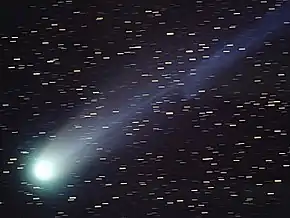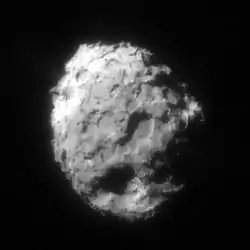13P/Olbers
13P/Olbers is a periodic comet with an orbital period of 69 years. It fits the classical definition of a Halley-type comet with (20 years < period < 200 years).[6]
| Discovery | |
|---|---|
| Discovered by | Heinrich Olbers |
| Discovery date | March 6, 1815 |
| Alternative designations | 1815 E1; 1887 Q1; 1887 V; 1887f; 1956 A1; 1956 IV; 1956a |
| Orbital characteristics A | |
| Epoch | 1956-10-14 (JD ?) |
| Aphelion | 32.6351 AU |
| Perihelion | 1.18 AU[1] |
| Semi-major axis | 16.9067774 AU[2] |
| Eccentricity | 0.93029715 |
| Orbital period | 69.5 a |
| Inclination | 44.60989° |
| Last perihelion | June 19, 1956[3] |
| Next perihelion | June 30, 2024[4][3][5] |
Heinrich Wilhelm Matthias Olbers (Bremen) discovered the comet on March 6, 1815. Its orbit was first computed by Carl Friedrich Gauss on March 31, Friedrich Bessel calculated an orbital period as 73 years, later as 73.9 years, calculations by other astronomers during that era resulted anywhere between 72 and 77 years.[7]
The comet was last detected in 1956.[7] It will next come to perihelion on June 30, 2024.[3] the comet will be closest to the Earth on January 10, 2094 when it passes at a distance of 0.756 AU.[7]
There is some speculation[8] that 13P/Olbers has an associated meteor shower on Mars coming from the direction of Beta Canis Major.
References
- F. Selsis, J. Brillet, M. Rapaport, Meteor showers of cometary origin in the Solar System: Revised predictions, Astronomy & Astrophysics, Vol. 416, pp. 783-789 (2004) doi:10.1051/0004-6361:20031724
- Sofie Spjuth, Search for Comet Ion Tail Encounters - prediction and data analysis (2005)
- Seiichi Yoshida (2004-07-31). "13P/Olbers". Seiichi Yoshida's Comet Catalog. Retrieved 2010-02-24.
- MPC
- Yeomans, Donald K. "Horizon Online Ephemeris System". California Institute of Technology, Jet Propulsion Laboratory. Retrieved 2007-12-14.
- "JPL Small-Body Database Browser: 13P/Olbers" (1956-09-12 last obs). Jet Propulsion Laboratory. Retrieved 2012-07-26.
- Kronk, Gary W. (2001–2005). "13P/Olbers". Retrieved 2012-02-22. (Cometography Home Page)
- "Meteor Showers And Their Parent Bodies". Archived from the original on 2008-10-03. Retrieved 2006-12-30.
External links
- Orbital simulation from JPL (Java) / Ephemeris
- 13P at Gary W. Kronk's Cometography
- 13P at Kazuo Kinoshita's Comets
- 13P at Seiichi Yoshida's Comet Catalog
| Numbered comets | ||
|---|---|---|
| Previous 12P/Pons–Brooks |
13P/Olbers | Next 14P/Wolf |


